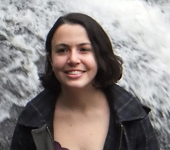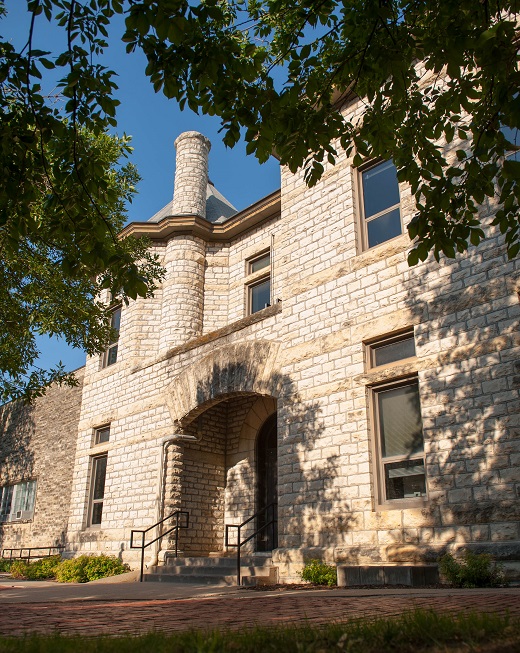08/05/20
K-State Current - August 5, 2020
K-State Current is a weekly news update for the Kansas Board of Regents to apprise the Regents on a few of the many successes and achievements made by K-State faculty, staff and students.
K-State News
Technology Development Institute assists in development of new agricultural product
 The Technology Development Institute at Kansas State University has provided a Salina entrepreneur and inventor with product development assistance for the Bac-Pac. The product can be used with a hydraulic bale bed to transport livestock, equipment, seed and feed or any other cargo that needs to be lifted from the ground onto a truck bed for transport.
The Technology Development Institute at Kansas State University has provided a Salina entrepreneur and inventor with product development assistance for the Bac-Pac. The product can be used with a hydraulic bale bed to transport livestock, equipment, seed and feed or any other cargo that needs to be lifted from the ground onto a truck bed for transport.
The Technology Development Institute at the Kansas State University Carl R. Ice College of Engineering has provided a Salina entrepreneur and inventor with the development assistance needed to get his newest product ready for interested manufacturers.
The institute, known as TDI, provided development assistance to Barry Reinert and his new product to assist ranchers with hydraulic bale beds. The Bac-Pac can be used with a hydraulic bale bed to transport livestock, equipment, seed and feed or any other cargo that needs to be lifted from the ground onto a truck bed for transport.
Reinert had been working closely with the Salina Community Economic Development Organization to move the concept for his product forward. They determined a product redesign was needed for its manufacturability as well as the creation of a drawing package for the manufacturer to be able to fabricate larger volumes of units. Reinert reached out to the TDI, whose staff of experienced engineering and business professionals provide assistance with the design, prototyping, testing and launching of new products and technologies to a wide range of companies and individuals.
Reinert sought TDI's help with combining the different functions of his two product prototypes into a single unit, reducing its weight and creating a set of drawings detailing the parts and assembly process. TDI's efforts met with success.
TDI worked closely with the Salina Community Economic Development team and reached out to several agencies to provide assistance with the project, including the Northwest Kansas Economic Innovation Center, or NWKEICI, a private foundation that serves 26 counties in northwest Kansas; the Kansas Department of Commerce; and the Economic Development Administration.
"The NWKEICI felt this was an innovative product that could make everyday functions in the agriculture industry more effective, so we were happy to assist with funding of the new prototype development," said Scott Sproul, president and CEO of the organization.
"This has been a great partnership from many different economic development groups across the state to help bring Barry's vision to a commercially ready product," said Bret Lanz, commercialization director for TDI. "Our next step is to locate a manufacturer seeking to add a new product to their line of agricultural products — hopefully here in the state of Kansas."
The Technology Development Institute, a U.S. Department of Commerce Economic Development Administration University Center, provides a broad range of engineering and business development services to both private industry and university researchers to advance the commercial readiness of new products or technologies. Additional information is available at k-state.edu/tdi.
New program is an outgrowth of 4-H Community Conversations
 An innovative 4-H program launched recently to encourage people to talk openly about society’s controversial topics is providing a springboard for an upcoming effort incorporating the visual arts.
An innovative 4-H program launched recently to encourage people to talk openly about society’s controversial topics is providing a springboard for an upcoming effort incorporating the visual arts.
Aliah Mestrovich Seay, a Kansas 4-H youth development specialist for culture and communication skills development, said the organization has formed a partnership with K-State’s Marianna Kistler Beach Museum of Art and the Institute for Civic Discourse and Democracy to offer the program, Visual Thinking Strategies.
“It’s an arts-based narrative inquiry that allows participants to be exposed to a series of different types of art, and unpack what is happening in those pieces of art in a very civil way,” Mestrovich Seay said, noting that the program is still three to six months from being fully launched.
“An arts-based narrative inquiry allows us to connect art and storytelling, and in this case, identity development. We try to connect our values, our beliefs and our behaviors through the medium of art and connect it to our lived experience. That allows us to build more understanding and awareness around our own selves – in this case our cultural self – and more awareness about the cultural selves of those who are different than we are.”
Listen to an interview with Aliah Mestrovich Seay, by Jeff Wichman
Led by trained youth and adult facilitators, the program will expose participants to artwork that depicts aspects of identity related to race, gender and other diversity dimensions.
Mestrovich Seay said Visual Thinking Strategies is a reflection of a program piloted the past year, called 4-H Community Conversations, which is led by trained youth facilitators who use their leadership and communication skills for reasoned, public discussion on what are often controversial topics.
Some of the subjects discussed recently in Community Conversations include health, safety, violence, education, drugs and alcohol abuse, bullying, rural and urban issues, and others. Youth and adults have been introduced to national models of public deliberation, including the National Issues Forum.
In the new program, Mestrovich Seay said the project’s partners will choose artwork depicting some aspect of a relevant social issue that would benefit from increased community dialogue.
“Art impacts people differently,” Mestrovich Seay said. “It will evoke different feelings and emotions and that’s what we’re shooting for. There is a way to go about doing this, different techniques we can use, and that’s why we have trained facilitators who will lead discussions.”
Timothy Shaffer, director of the Institute for Civic Discourse and Democracy, said Visual Thinking Strategies invites participants to reflect on their own ideas and assumptions.
“Today, this is a crucial skill for members of a diverse society in order to have the ability to view something with others and see something differently from others,” he said. “Using the Visual Thinking Strategies model of discussion, people will be able to explain these differences and, in the process, come to better understand why someone else potentially is seeing something different than they do.”
For now, the youth trained as facilitators during Community Conversations will also be trained to lead discussion in Visual Thinking Strategies, according to Mestrovich Seay.
“Typically what happens is that the facilitator will ask the audience an open-ended question, like ‘what’s going on in this picture?’” she said. “That allows people to openly interpret and express themselves and share what they see.”
The next question, typically, is to ask participants what they are seeing that led to their answer.
“We ask for visual evidence, not just what they think,” Mestrovich Seay said. “That’s a way to build their critical thinking skills around art.”
And finally, she adds, the facilitator asks what more can be found in the picture.
“Just like when we’re talking about societal issues that are really difficult, that question brings up tough conversations and maybe even conflict,” Mestrovich Seay said. “There are multiple answers to that question, so it promotes flexible thinking. All of this ties into the principles of civic and civil discourse.”
Shaffer adds: “Visual Thinking Strategies is a tremendous tool for inviting people to pause and reflect on an image, even one that seems to have a ‘right answer.’ Being asked to consider alternatives to how one sees an image is a helpful reminder that we see -- and experience -- the world differently.”
The program will be offered through the Kansas 4-H Youth Development program, and will be open to people of all ages, including adults. Mestrovich Seay said organizers are currently working to train adult facilitators, extension agents and volunteers to participate, as well.
“I am so excited about how this innovative program, with a diverse set of partners, will continue to grow youth skills to become effective community leaders,” said Wade Weber, the state program leader for Kansas 4-H.
More information on Visual Thinking Strategies will be available on the Kansas 4-H Youth Development website as it becomes available.
K-State Faculty Highlights
Geography and geospatial sciences faculty member to lead $500,000 USDA grant
 Katherine Nelson, assistant professor of geography and geospatial sciences, recently received an Agriculture and Food Research Initiative grant from the U.S. Department of Agriculture totaling $499,948 over three years to investigate sustainable agriculture that supports long-term food security.
Katherine Nelson, assistant professor of geography and geospatial sciences, recently received an Agriculture and Food Research Initiative grant from the U.S. Department of Agriculture totaling $499,948 over three years to investigate sustainable agriculture that supports long-term food security.
Nelson will lead the multi-institutional, interdisciplinary project conducted with co-investigators Jeremy Cowan, Kansas State University horticulture and natural resources department; and Emily Burchfield, Emory University environmental sciences department.
During the project, "Agricultural Landscape Management for Improved Sustainability: Quantifying Relationships, Barriers, and Opportunities," Nelson, Cowan and Burchfield will examine how landscape simplification affects agricultural productivity and identify barriers and bridges to diversification in agricultural landscapes using a combination of data-driven modeling and in-depth localized case studies. The team's goal is to generate knowledge on the connections between landscape diversity, agricultural production and human activities that will enable development of locally relevant landscape diversification strategies that provide synergistic benefits for agricultural and ecological systems and that support the long-term viability of U.S. agriculture.
K-State Student Highlights
Doctoral student publishes paper on nanoscience discovery
 Pingping Chen, doctoral student in industrial and manufacturing systems engineering, had her work published and named an editor's pick in the July 14 issue of the Journal of Applied Physics.
Pingping Chen, doctoral student in industrial and manufacturing systems engineering, had her work published and named an editor's pick in the July 14 issue of the Journal of Applied Physics.
The article, "High-Field Electromagnetic Radiation Converts Carbon Nanotubes to Nanoribbons Embedded with Carbon Nanocrystals," demonstrates a route to synthesize nanoscale ribbons of graphene that could be building blocks for a number of applications. Graphene, atomic thin carbon arranged in honeycomb geometry, has revolutionized nanoscience since its discovery in 2004, but researchers around the world trying to enable its use for an electronic switch still find it lacking in some of its fundamental physics.
Now a group of K-State researchers, led by Suprem Das, Chen's advising professor, and including Xinya Wang, Shuting Lei and Brice Lacroix, are using ultrafast laser radiation to nano-manufacture graphene nanoribbons and carbon nanocrystals from carbon nanotubes. The group also collaborates with Y. Luan and Zhe Fei at the Iowa State University physics department and the U.S. Department of Energy's Ames Laboratory for the project.
Chen's paper is part of the special collection on Materials for Quantum Technologies: Computing, Information and Sensing, and the work had been filed as a provisional patent application by K-State Innovation Partners.
Two JMC students awarded American Advertising Federation Foundation Scholarship
 Two students studying in the A.Q. Miller School of Journalism and Mass Communications received the competitive American Advertising Federation Foundation Scholarship for the 2020-2021 academic year.
Two students studying in the A.Q. Miller School of Journalism and Mass Communications received the competitive American Advertising Federation Foundation Scholarship for the 2020-2021 academic year.
Kathryn Hurd and Kate Torline, both in strategic communications, were announced as winners by the American Advertising Federation-Kansas City on July 18.
As part of the scholarship package, each winner will receive support and counsel of a mentor from the membership of the professional American Advertising Federation network in Kansas City. They also will receive a one-year membership in the American Advertising Federation-Kansas City, invitation to all regular program activities of the association at no cost, membership in the American Advertising Federation, and a $1,500 scholarship.
The AAF-KC Foundation Scholarship was created to award college students who show a passion for advertising, marketing and graphic arts studies.
"Kat and Kate are both highly involved and engaged in strategic communications inside and outside of the classroom," said Katie Olsen, assistant professor in JMC's strategic communications sequence and Ad Club advisor. "Kate's been a key member of the Manhappenin' magazine team, and Kat has served as the creative lead in the Collegian Media Group's advertising department. Their drive to gain professional experience sets them apart. We are so proud and can't wait to see what their futures hold."
For more information about Ad Club, K-State's collegiate American Advertising Federation chapter, contact Olsen at olsenk@k-state.edu.